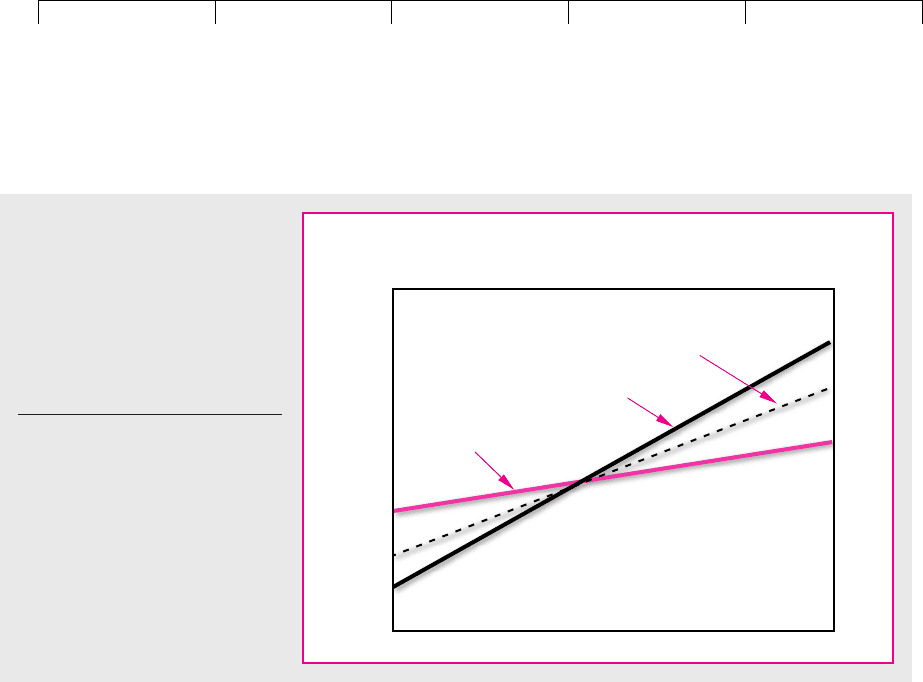Brealey, Myers. Principles of Corporate Finance. 7th edition
Подождите немного. Документ загружается.


Brealey−Meyers:
Principles of Corporate
Finance, Seventh Edition
X. Mergers, Corporate
Control, and Governance
33. Mergers
© The McGraw−Hill
Companies, 2003
Mergers that take place between two firms in the same line of business are known
as horizontal mergers. Recent examples include bank mergers, such as Chemical
Bank’s merger with Chase and Nationsbank’s purchase of BankAmerica. Other
headline-grabbing horizontal mergers include those between oil giants Exxon and
Mobil, and between British Petroleum (BP) and Amoco.
A vertical merger involves companies at different stages of production. The buyer
expands back toward the source of raw materials or forward in the direction of the
ultimate consumer. An example is Walt Disney’s acquisition of the ABC television
network. Disney planned to use the ABC network to show The Lion King and other
recent movies to huge audiences.
A conglomerate merger involves companies in unrelated lines of businesses. The
majority of mergers in the 1960s and 1970s were conglomerate. They became less
popular in the 1980s. In fact, much of the action since the 1980s has come from
breaking up the conglomerates that had been formed 10 to 20 years earlier.
With these distinctions in mind, we are about to consider motives for mergers,
that is, reasons why two firms may be worth more together than apart. We proceed
with some trepidation. The motives, though they often lead the way to real bene-
fits, are sometimes just mirages that tempt unwary or overconfident managers into
takeover disasters. This was the case for AT&T, which spent $7.5 billion to buy
NCR. The aim was to shore up AT&T’s computer business and to “link people, or-
ganizations and their information into a seamless, global computer network.”
1
It
didn’t work. Even more embarrassing (on a smaller scale) was the acquisition of
Apex One, a sporting apparel company, by Converse Inc. The purchase was made
on May 18, 1995. Apex One was closed down on August 11, after Converse failed
to produce new designs quickly enough to satisfy retailers. Converse lost an in-
vestment of over $40 million in 85 days.
2
Many mergers that seem to make economic sense fail because managers cannot
handle the complex task of integrating two firms with different production processes,
accounting methods, and corporate cultures. This was one of the problems in the
AT&T–NCR merger. It also bedeviled Novell’s acquisition of Wordperfect. That
merger at first seemed a perfect fit between Novell’s strengths in networks for per-
sonal computers and Wordperfect’s applications software. But Wordperfect’s postac-
quisition sales were horrible, partly because of competition from other word process-
ing systems but also because of a series of battles over turf and strategy:
Wordperfect executives came to view Novell executives as rude invaders of the
corporate equivalent of Camelot. They repeatedly fought with . . . Novell’s staff
over everything from expenses and management assignments to Christmas
bonuses. [This led to] a strategic mistake: dismantling a Wordperfect sales team . . .
needed to push a long-awaited set of office software products.
3
The value of most businesses depends on human assets—managers, skilled
workers, scientists, and engineers. If these people are not happy in their new roles
930 PART X
Mergers, Corporate Control, and Governance
33.1 SENSIBLE MOTIVES FOR MERGERS
1
Robert E. Allen, AT&T chairman, quoted in J. J. Keller, “Disconnected Line: Why AT&T Takeover of
NCR Hasn’t Been a Real Bell Ringer,” The Wall Street Journal, September 9, 1995, p. A1.
2
Mark Maremount, “How Converse Got Its Laces All Tangled,” Business Week, September 4, 1995, p. 37.
3
D. Clark, “Software Firm Fights to Remake Business after Ill-Fated Merger,” The Wall Street Journal, Jan-
uary 12, 1996, p. A1.

Brealey−Meyers:
Principles of Corporate
Finance, Seventh Edition
X. Mergers, Corporate
Control, and Governance
33. Mergers
© The McGraw−Hill
Companies, 2003
in the acquiring firm, the best of them will leave. One Portuguese bank (BCP)
learned this lesson the hard way when it bought an investment management firm
against the wishes of the firm’s employees. The entire workforce immediately quit
and set up a rival investment management firm with a similar name. Beware of
paying too much for assets that go down in the elevator and out to the parking lot
at the close of each business day. They may drive into the sunset and never return.
There are also occasions when the merger does achieve gains but the buyer nev-
ertheless loses because it pays too much. For example, the buyer may overestimate
the value of stale inventory or underestimate the costs of renovating old plant and
equipment, or it may overlook the warranties on a defective product. Buyers need
to be particularly careful about environmental liabilities. If there is pollution from
the seller’s operations or toxic waste on its property, the costs of cleaning up will
probably fall on the buyer.
Economies of Scale
Just as most of us believe that we would be happier if only we were a little richer,
so every manager seems to believe that his or her firm would be more competitive
if only it were just a little bigger. Achieving economies of scale is the natural goal of
horizontal mergers. But such economies have been claimed in conglomerate merg-
ers, too. The architects of these mergers have pointed to the economies that come
from sharing central services such as office management and accounting, financial
control, executive development, and top-level management.
4
The most prominent recent examples of mergers in pursuit of economies of
scale come from the banking industry. The United States entered the 1990s with
far too many banks, largely as a result of outdated regulations on interstate
banking. As these regulations eroded and communications and technology im-
proved, hundreds of small banks were bought out and merged into regional or
“supra-regional” firms. When Chase and Chemical, two of the largest money-
center banks, merged, they forecasted that the merger would reduce costs by
16 percent a year, or $1.5 billion. The savings would come from consolidating
operations and eliminating redundant costs.
5
Optimistic financial managers can see potential economies of scale in almost
any industry. But it is easier to buy another business than to integrate it with yours
afterward. Some companies that have gotten together in pursuit of scale economies
still function as a collection of separate and sometimes competing operations with
different production facilities, research efforts, and marketing forces.
Economies of Vertical Integration
Vertical mergers seek economies in vertical integration. Some companies try to
gain control over the production process by expanding back toward the output of
the raw material and forward to the ultimate consumer. One way to achieve this is
to merge with a supplier or a customer.
CHAPTER 33
Mergers 931
4
Economies of scale are enjoyed when the average unit cost of production goes down as production in-
creases. One way to achieve economies of scale is to spread fixed costs over a larger volume of production.
5
Houston et al. examine 41 large bank mergers in which the companies provided forecasts of cost sav-
ings. On average the estimated present value of these savings was about 12 percent of the market value
of the combined companies. See J. F. Houston, C. M. James, and M. D. Ryngaert, “Where Do Merger
Gains Come from? Bank Mergers from the Perspective of Insiders and Outsiders,” Journal of Financial
Economics 60 (2001), pp. 285–331.

Brealey−Meyers:
Principles of Corporate
Finance, Seventh Edition
X. Mergers, Corporate
Control, and Governance
33. Mergers
© The McGraw−Hill
Companies, 2003
Vertical integration facilitates coordination and administration. We illustrate
via an extreme example. Think of an airline that does not own any planes. If it
schedules a flight from Boston to San Francisco, it sells tickets and then rents a
plane for that flight from a separate company. This strategy might work on a
small scale, but it would be an administrative nightmare for a major carrier,
which would have to coordinate hundreds of rental agreements daily. In view of
these difficulties, it is not surprising that all major airlines have integrated back-
ward, away from the consumer, by buying and flying airplanes rather than pa-
tronizing rent-a-plane companies.
Do not assume that more vertical integration is better than less. Carried to ex-
tremes, it is absurdly inefficient, as in the case of LOT, the Polish state airline,
which in the late 1980s found itself raising pigs to make sure that its employees
had fresh meat on their tables. (Of course, in a centrally managed economy it may
be necessary to raise your own cattle or pigs, since you can’t be sure you’ll be able
to buy meat.)
Nowadays the tide of vertical integration seems to be flowing out. Companies
are finding it more efficient to outsource the provision of many services and various
types of production. For example, back in the 1950s and 1960s, General Motors was
deemed to have a cost advantage over its main competitors, Ford and Chrysler, be-
cause a greater fraction of the parts used in GM’s automobiles were produced in-
house. By the 1990s, Ford and Chrysler had the advantage: They could buy the
parts cheaper from outside suppliers. This was partly because the outside suppli-
ers tended to use nonunion labor at lower wages. But it also appears that manu-
facturers have more bargaining power versus independent suppliers than versus
a production facility that’s part of the corporate family. In 1998 GM decided to spin
off Delphi, its automotive parts division, as a separate company.
6
After the spin-
off, GM can continue to buy parts from Delphi in large volumes, but it negotiates
the purchases at arm’s length.
7
Complementary Resources
Many small firms are acquired by large ones that can provide the missing ingredi-
ents necessary for the small firms’ success. The small firm may have a unique prod-
uct but lack the engineering and sales organization required to produce and mar-
ket it on a large scale. The firm could develop engineering and sales talent from
scratch, but it may be quicker and cheaper to merge with a firm that already has
ample talent. The two firms have complementary resources—each has what the other
needs—and so it may make sense for them to merge. The two firms are worth more
together than apart because each acquires something it does not have and gets it
cheaper than it would by acting on its own. Also, the merger may open up oppor-
tunities that neither firm would pursue otherwise.
Of course, two large firms may also merge because they have complementary
resources. Consider the 1989 merger between two electric utilities, Utah Power &
Light and PacifiCorp, which served customers in California. Utah Power’s peak
demand came in the summer, for air conditioning. PacifiCorp’s peak came in the
winter, for heating. The savings from combining the two firms’ generating systems
were estimated at $45 million annually.
932 PART X
Mergers, Corporate Control, and Governance
6
We cover spin-offs in the next chapter.
7
In 2000 Ford followed GM by announcing plans to spin off its auto-parts business, Visteon Corporation.

Brealey−Meyers:
Principles of Corporate
Finance, Seventh Edition
X. Mergers, Corporate
Control, and Governance
33. Mergers
© The McGraw−Hill
Companies, 2003
Surplus Funds
Here’s another argument for mergers: Suppose that your firm is in a mature in-
dustry. It is generating a substantial amount of cash, but it has few profitable in-
vestment opportunities. Ideally such a firm should distribute the surplus cash to
shareholders by increasing its dividend payment or repurchasing stock. Unfortu-
nately, energetic managers are often reluctant to adopt a policy of shrinking their
firm in this way. If the firm is not willing to purchase its own shares, it can instead
purchase another company’s shares. Firms with a surplus of cash and a shortage
of good investment opportunities often turn to mergers financed by cash as a way of
redeploying their capital.
Some firms have excess cash and do not pay it out to stockholders or rede-
ploy it by wise acquisitions. Such firms often find themselves targeted for
takeover by other firms that propose to redeploy the cash for them.
8
During the
oil price slump of the early 1980s, many cash-rich oil companies found them-
selves threatened by takeover. This was not because their cash was a unique as-
set. The acquirers wanted to capture the companies’ cash flow to make sure it
was not frittered away on negative-NPV oil exploration projects. We return to
this free-cash-flow motive for takeovers later in this chapter.
Eliminating Inefficiencies
Cash is not the only asset that can be wasted by poor management. There are al-
ways firms with unexploited opportunities to cut costs and increase sales and earn-
ings. Such firms are natural candidates for acquisition by other firms with better
management. In some instances “better management” may simply mean the de-
termination to force painful cuts or realign the company’s operations. Notice that
the motive for such acquisitions has nothing to do with benefits from combining
two firms. Acquisition is simply the mechanism by which a new management team
replaces the old one.
A merger is not the only way to improve management, but sometimes it is the
only simple and practical way. Managers are naturally reluctant to fire or demote
themselves, and stockholders of large public firms do not usually have much direct
influence on how the firm is run or who runs it.
9
If this motive for merger is important, one would expect to observe that acqui-
sitions often precede a change in the management of the target firm. This seems to
be the case. For example, Martin and McConnell found that the chief executive is
four times more likely to be replaced in the year after a takeover than during ear-
lier years.
10
The firms they studied had generally been poor performers; in the four
years before acquisition their stock prices had lagged behind those of other firms
in the same industry by 15 percent. Apparently many of these firms fell on bad
times and were rescued, or reformed, by merger.
Of course, it is easy to criticize another firm’s management but not so easy to im-
prove it. Some of the self-appointed scourges of poor management turn out to be
CHAPTER 33
Mergers 933
8
Takeovers in this case often take the form of leveraged buy-outs. See Chapter 34.
9
It is difficult to assemble a large-enough block of stockholders to effectively challenge management
and the incumbent board of directors. Stockholders can have enormous indirect influence, however.
Their displeasure shows up in the firm’s stock price. A low stock price may encourage a takeover bid
by another firm.
10
K. J. Martin and J. J. McConnell, “Corporate Performance, Corporate Takeovers, and Management
Turnover,” Journal of Finance 46 (June 1991), pp. 671–687.

Brealey−Meyers:
Principles of Corporate
Finance, Seventh Edition
X. Mergers, Corporate
Control, and Governance
33. Mergers
© The McGraw−Hill
Companies, 2003
less competent than those they replace. Here is how Warren Buffet, the chairman
of Berkshire Hathaway, summarizes the matter:
11
Many managers were apparently over-exposed in impressionable childhood years
to the story in which the imprisoned, handsome prince is released from the toad’s
body by a kiss from the beautiful princess. Consequently, they are certain that the
managerial kiss will do wonders for the profitability of the target company. Such
optimism is essential. Absent that rosy view, why else should the shareholders of
company A want to own an interest in B at a takeover cost that is two times the mar-
ket price they’d pay if they made direct purchases on their own? In other words in-
vestors can always buy toads at the going price for toads. If investors instead
bankroll princesses who wish to pay double for the right to kiss the toad, those
kisses better pack some real dynamite. We’ve observed many kisses, but very few
miracles. Nevertheless, many managerial princesses remain serenely confident
about the future potency of their kisses, even after their corporate backyards are
knee-deep in unresponsive toads.
934 PART X Mergers, Corporate Control, and Governance
11
Berkshire Hathaway 1981 Annual Report, cited in G. Foster, “Comments on M&A Analysis and the
Role of Investment Bankers,” Midland Corporate Finance Journal 1 (Winter 1983), pp. 36–38.
33.2 SOME DUBIOUS REASONS FOR MERGERS
The benefits that we have described so far all make economic sense. Other arguments
sometimes given for mergers are dubious. Here are a few of the dubious ones.
To Diversify
We have suggested that the managers of a cash-rich company may prefer to see it
use that cash for acquisitions rather than distribute it as extra dividends. That is
why we often see cash-rich firms in stagnant industries merging their way into
fresh woods and pastures new.
What about diversification as an end in itself? It is obvious that diversification
reduces risk. Isn’t that a gain from merging?
The trouble with this argument is that diversification is easier and cheaper for
the stockholder than for the corporation. No one has shown that investors pay a
premium for diversified firms; in fact, discounts are common. For example, Kaiser
Industries was dissolved as a holding company because its diversification appar-
ently subtracted from its value. Kaiser Industries’ main assets were shares of Kaiser
Steel, Kaiser Aluminum, and Kaiser Cement. These were independent companies,
and the stock of each was publicly traded. Thus you could value Kaiser Industries
by looking at the stock prices of Kaiser Steel, Kaiser Aluminum, and Kaiser Ce-
ment. But Kaiser Industries’ stock was selling at a price reflecting a significant dis-
count from the value of its investment in these companies. The discount vanished
when Kaiser Industries revealed its plan to sell its holdings and distribute the pro-
ceeds to its stockholders.
Why the discount existed in the first place is a puzzle. But the example at least
shows that diversification does not increase value. The appendix to this chapter
provides a simple proof that corporate diversification does not affect value in per-
fect markets as long as investors’ diversification opportunities are unrestricted.
This is the value-additivity principle introduced in Chapter 7.

Brealey−Meyers:
Principles of Corporate
Finance, Seventh Edition
X. Mergers, Corporate
Control, and Governance
33. Mergers
© The McGraw−Hill
Companies, 2003
Increasing Earnings per Share: The Bootstrap Game
During the 1960s some conglomerate companies made acquisitions that offered no
evident economic gains. Nevertheless the conglomerates’ aggressive strategy pro-
duced several years of rising earnings per share. To see how this can happen, let us
look at the acquisition of Muck and Slurry by the well-known conglomerate World
Enterprises.
12
The position before the merger is set out in the first two columns of Table 33.2. No-
tice that because Muck and Slurry has relatively poor growth prospects, its stock sells
at a lower price–earnings ratio than does World Enterprises’ stock (line 3). The merger,
we assume, produces no economic benefits, and so the firms should be worth exactly
the same together as they are apart. The market value of World Enterprises after the
merger should be equal to the sum of the separate values of the two firms (line 6).
Since World Enterprises’ stock is selling for double the price of Muck and Slurry
stock (line 2), World Enterprises can acquire the 100,000 Muck and Slurry shares
for 50,000 of its own shares. Thus World will have 150,000 shares outstanding after
the merger.
Total earnings double as a result of the merger (line 5), but the number of shares
increases by only 50 percent. Earnings per share rise from $2.00 to $2.67. We call this
the bootstrap effect because there is no real gain created by the merger and no in-
crease in the two firms’ combined value. Since the stock price is unchanged, the
price–earnings ratio falls (line 3).
Figure 33.1 illustrates what is going on here. Before the merger $1 invested in
World Enterprises bought 5 cents of current earnings and rapid growth prospects.
On the other hand, $1 invested in Muck and Slurry bought 10 cents of current earn-
ings but slower growth prospects. If the total market value is not altered by the
merger, then $1 invested in the merged firm gives 6.7 cents of immediate earnings
but slower growth than World Enterprises offered alone. Muck and Slurry share-
holders get lower immediate earnings but faster growth. Neither side gains or
loses provided everybody understands the deal.
Financial manipulators sometimes try to ensure that the market does not under-
stand the deal. Suppose that investors are fooled by the exuberance of the president
CHAPTER 33
Mergers 935
12
The discussion of the bootstrap game follows S. C. Myers, “A Framework for Evaluating Mergers,” in
S. C. Myers (ed.), Modern Developments in Financial Management, Frederick A. Praeger, Inc., New York, 1976.
World Enterprises Muck and World Enterprises
before Merger Slurry after Merger
1. Earnings per share $2.00 $2.00 $2.67
2. Price per share $40 $20 $40
3. Price–earnings ratio 20 10 15
4. Number of shares 100,000 100,000 150,000
5. Total earnings $200,000 $200,000 $400,000
6. Total market value $4,000,000 $2,000,000 $6,000,000
7. Current earnings
per dollar invested
in stock
(line 1 line 2) $.05 $.10 $.067
TABLE 33.2
Impact of merger on market
value and earnings per share
of World Enterprises.
Note: When World Enterprises
purchases Muck and Slurry, there
are no gains. Therefore, total
earnings and total market value
should be unaffected by the
merger. But earnings per share
increase. World Enterprises issues
only 50,000 of its shares (priced at
$40) to acquire the 100,000 Muck
and Slurry shares (priced at $20).

Brealey−Meyers:
Principles of Corporate
Finance, Seventh Edition
X. Mergers, Corporate
Control, and Governance
33. Mergers
© The McGraw−Hill
Companies, 2003
of World Enterprises and by plans to introduce modern management techniques into
its new Earth Sciences Division (formerly known as Muck and Slurry). They could
easily mistake the 33 percent postmerger increase in earnings per share for real
growth. If they do, the price of World Enterprises stock rises and the shareholders of
both companies receive something for nothing.
You should now see how to play the bootstrap, or “chain letter,” game. Suppose
that you manage a company enjoying a high price–earnings ratio. The reason why
it is high is that investors anticipate rapid growth in future earnings. You achieve
this growth not by capital investment, product improvement, or increased operat-
ing efficiency but by the purchase of slow-growing firms with low price–earnings
ratios. The long-run result will be slower growth and a depressed price–earnings
ratio, but in the short run earnings per share can increase dramatically. If this fools
investors, you may be able to achieve higher earnings per share without suffering
a decline in your price–earnings ratio. But to keep fooling investors, you must con-
tinue to expand by merger at the same compound rate. Obviously you cannot do this
forever; one day expansion must slow down or stop. Then earnings growth will
cease, and your house of cards will fall.
This kind of game is not played so often now. But there is still a widespread be-
lief that a firm should not acquire companies with higher price–earnings ratios
than its own. Of course you know better than to believe that low-P/E stocks are
cheap and high-P/E stocks are dear. If life were as simple as that, we should all be
wealthy by now. Beware of false prophets who suggest that you can appraise
mergers just on the basis of their immediate impact on earnings per share.
Lower Financing Costs
You often hear it said that a merged firm is able to borrow more cheaply than its
separate units could. In part this is true. We have already seen (in Section 15.4) that
936 PART X
Mergers, Corporate Control, and Governance
World Enterprises before merger
World Enterprises after merger
Muck and Slurry
Now
Time
.10
.05
.067
Earnings per dollar
invested
(log scale)
FIGURE 33.1
Effects of merger on earnings
growth. By merging with Muck and
Slurry, World Enterprises increases
current earnings but accepts a
slower rate of future growth. Its
stockholders should be no better or
worse off unless investors are
fooled by the bootstrap effect.
Source: S. C. Myers, “A Framework for
Evaluating Mergers,” in S. C. Myers, ed.,
Modern Developments in Financial
Management, Frederick A. Praeger, Inc.,
New York, 1976, Figure 1, p. 639.

Brealey−Meyers:
Principles of Corporate
Finance, Seventh Edition
X. Mergers, Corporate
Control, and Governance
33. Mergers
© The McGraw−Hill
Companies, 2003
there are significant economies of scale in making new issues. Therefore, if firms
can make fewer, larger security issues by merging, there are genuine savings.
But when people say that borrowing costs are lower for the merged firm, they
usually mean something more than lower issue costs. They mean that when two
firms merge, the combined company can borrow at lower interest rates than either
firm could separately. This, of course, is exactly what we should expect in a well-
functioning bond market. While the two firms are separate, they do not guarantee each
other’s debt; if one fails, the bondholder cannot ask the other for money. But after the
merger each enterprise effectively does guarantee the other’s debt; if one part of the
business fails, the bondholders can still take their money out of the other part. Because
these mutual guarantees make the debt less risky, lenders demand a lower interest rate.
Does the lower interest rate mean a net gain to the merger? Not necessarily.
Compare the following two situations:
• Separate issues. Firm A and firm B each make a $50 million bond issue.
• Single issue. Firms A and B merge, and the new firm AB makes a single
$100 million issue.
Of course AB would pay a lower interest rate, other things being equal. But it does
not make sense for A and B to merge just to get that lower rate. Although AB’s
shareholders do gain from the lower rate, they lose by having to guarantee each
other’s debt. In other words, they get the lower interest rate only by giving bond-
holders better protection. There is no net gain.
In Sections 20.2 and 24.5 we showed that
Merger increases bond value (or reduces the interest payments necessary to sup-
port a given bond value) only by reducing the value of stockholders’ options to de-
fault. In other words, the value of the default option for AB’s $100 million issue
is less than the combined value of the two default options on A’s and B’s separate
$50 million issues.
Now suppose that A and B each borrow $50 million and then merge. If the
merger is a surprise, it is likely to be a happy one for the bondholders. The bonds
they thought were guaranteed by one of the two firms end up guaranteed by both.
The stockholders lose in this case because they have given bondholders better pro-
tection but have received nothing for it.
There is one situation in which mergers can create value by making debt safer.
In Section 18.3 we described the choice of an optimal debt ratio as a trade-off of the
value of tax shields on interest payments made by the firm against the present
value of possible costs of financial distress due to borrowing too much. Merging
decreases the probability of financial distress, other things being equal. If it allows
increased borrowing, and increased value from the interest tax shields, there will
be a net gain to the merger.
13
Bond value
bond value
assuming no2
chance of default
value of
shareholders’ 1put2
option to default
CHAPTER 33
Mergers 937
13
This merger rationale was first suggested by W. G. Lewellen, “A Pure Financial Rationale for the Con-
glomerate Merger,” Journal of Finance 26 (May 1971), pp. 521–537. If you want to see some of the con-
troversy and discussion that this idea led to, look at R. C. Higgins and L. D. Schall, “Corporate Bank-
ruptcy and Conglomerate Merger,” Journal of Finance 30 (March 1975), pp. 93–114; and D. Galai and
R. W. Masulis, “The Option Pricing Model and the Risk Factor of Stock,” Journal of Financial Economics
3 (January–March 1976), especially pp. 66–69.

Brealey−Meyers:
Principles of Corporate
Finance, Seventh Edition
X. Mergers, Corporate
Control, and Governance
33. Mergers
© The McGraw−Hill
Companies, 2003
Suppose that you are the financial manager of firm A and you want to analyze
the possible purchase of firm B.
14
The first thing to think about is whether there
is an economic gain from the merger. There is an economic gain only if the two
firms are worth more together than apart. For example, if you think that the com-
bined firm would be worth and that the separate firms are worth and
, then
If this gain is positive, there is an economic justification for merger. But you also
have to think about the cost of acquiring firm B. Take the easy case in which pay-
ment is made in cash. Then the cost of acquiring B is equal to the cash payment mi-
nus B’s value as a separate entity. Thus
The net present value to A of a merger with B is measured by the difference be-
tween the gain and the cost. Therefore, you should go ahead with the merger if its
net present value, defined as
is positive.
We like to write the merger criterion in this way because it focuses attention on
two distinct questions. When you estimate the benefit, you concentrate on whether
there are any gains to be made from the merger. When you estimate cost, you are
concerned with the division of these gains between the two companies.
An example may help make this clear. Firm A has a value of $200 million, and B
has a value of $50 million. Merging the two would allow cost savings with a pres-
ent value of $25 million. This is the gain from the merger. Thus,
Suppose that B is bought for cash, say, for $65 million. The cost of the merger is
Note that the stockholders of firm B—the people on the other side of the transaction—
are ahead by $15 million. Their gain is your cost. They have captured $15 million of the
$25 million merger gain. Thus when we write down the NPV of the merger from A’s
viewpoint, we are really calculating that part of the gain which A’s stockholders get
65 50 $15 million
Cost cash paid PV
B
PV
AB
$275 million
Gain ∆PV
AB
$25
PV
B
$50
PV
A
$200
∆PV
AB
1cash PV
B
2
NPV gain cost
Cost cash paid PV
B
Gain PV
AB
1PV
A
PV
B
2 ∆PV
AB
PV
B
PV
A
PV
AB
938 PART X Mergers, Corporate Control, and Governance
33.3 ESTIMATING MERGER GAINS AND COSTS
14
This chapter’s definitions and interpretations of the gains and costs of merger follow those set out in
S. C. Myers, “A Framework for Evaluating Mergers,” op. cit.

Brealey−Meyers:
Principles of Corporate
Finance, Seventh Edition
X. Mergers, Corporate
Control, and Governance
33. Mergers
© The McGraw−Hill
Companies, 2003
to keep. The NPV to A’s stockholders equals the overall gain from the merger less that
part of the gain captured by B’s stockholders:
Just as a check, let’s confirm that A’s stockholders really come out $10 million
ahead. They start with a firm worth million. They end up with a firm
worth $275 million and then have to pay out $65 million to B’s stockholders.
15
Thus
their net gain is
Suppose investors do not anticipate the merger between A and B. The an-
nouncement will cause the value of B’s stock to rise from $50 million to $65 million,
a 30 percent increase. If investors share management’s assessment of the merger
gains, the market value of A’s stock will increase by $10 million, only a 5 percent
increase.
It makes sense to keep an eye on what investors think the gains from merging are.
If A’s stock price falls when the deal is announced, then investors are sending the mes-
sage that the merger benefits are doubtful or that A is paying too much for them.
16
Right and Wrong Ways to Estimate the Benefits of Mergers
Some companies begin their merger analyses with a forecast of the target firm’s fu-
ture cash flows. Any revenue increases or cost reductions attributable to the merger
are included in the forecasts, which are then discounted back to the present and
compared with the purchase price:
This is a dangerous procedure. Even the brightest and best-trained analyst can
make large errors in valuing a business. The estimated net gain may come up pos-
itive not because the merger makes sense but simply because the analyst’s cash-
flow forecasts are too optimistic. On the other hand, a good merger may not be pur-
sued if the analyst fails to recognize the target’s potential as a stand-alone business.
Our procedure starts with the target’s stand-alone market value and con-
centrates on the changes in cash flow that would result from the merger. Ask your-
self why the two firms should be worth more together than apart.
The same advice holds when you are contemplating the sale of part of your busi-
ness. There is no point in saying to yourself, This is an unprofitable business and
should be sold. Unless the buyer can run the business better than you can, the price
you receive will reflect the poor prospects.
1PV
B
2
Estimated
net gain
DCF valuation
of target,
including
merger benefits
cash required
for acquisition
1$275 $652 $200 $10 million
1PV
AB
cash2 PV
A
NPV wealth with merger wealth without merger
PV
A
$200
NPV 25 15 $10 million
CHAPTER 33 Mergers 939
15
We are assuming that includes enough cash to finance the deal, or that the cash can be borrowed
at a market interest rate. Notice that the value to A’s stockholders after the deal is done and paid for is
million—a gain of $10 million.
16
Think back to Section 13.4, where we saw how Hewlett Packard’s stock price fell when it announced
its plans to merge with Compaq.
$275 65 $210
PV
A
